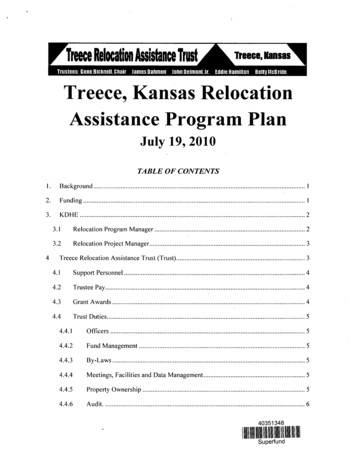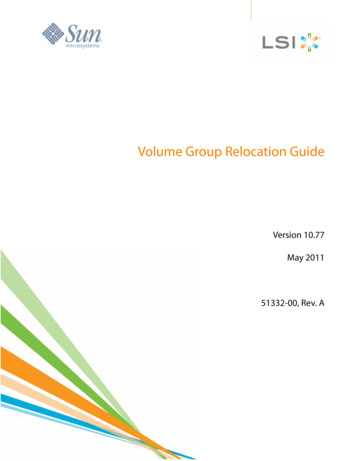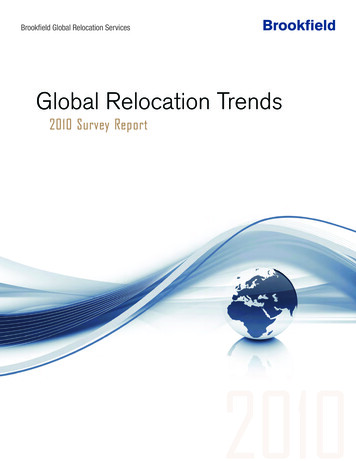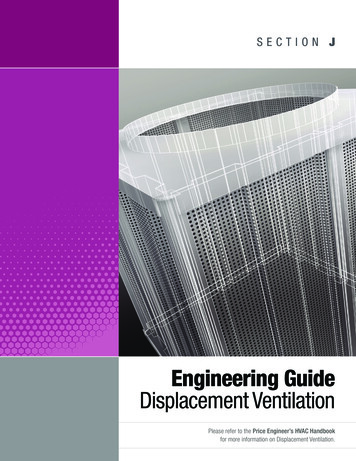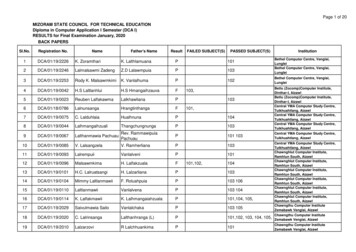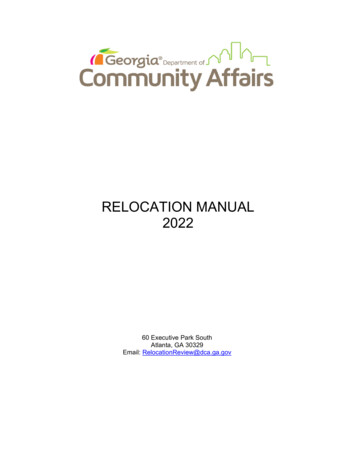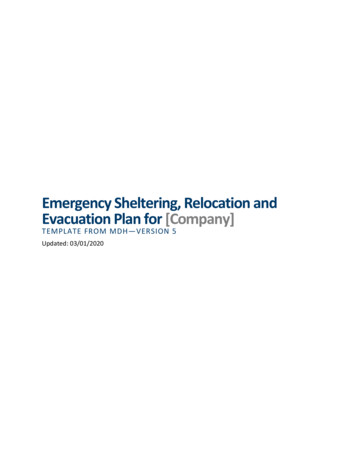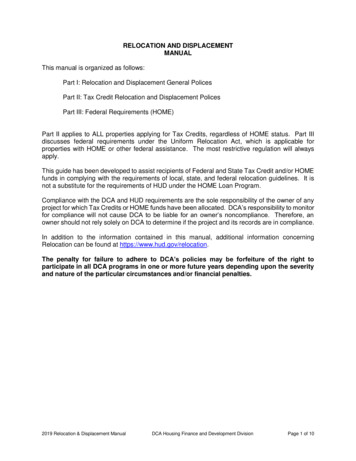
Transcription
RELOCATION AND DISPLACEMENTMANUALThis manual is organized as follows:Part I: Relocation and Displacement General PolicesPart II: Tax Credit Relocation and Displacement PolicesPart III: Federal Requirements (HOME)Part II applies to ALL properties applying for Tax Credits, regardless of HOME status. Part IIIdiscusses federal requirements under the Uniform Relocation Act, which is applicable forproperties with HOME or other federal assistance. The most restrictive regulation will alwaysapply.This guide has been developed to assist recipients of Federal and State Tax Credit and/or HOMEfunds in complying with the requirements of local, state, and federal relocation guidelines. It isnot a substitute for the requirements of HUD under the HOME Loan Program.Compliance with the DCA and HUD requirements are the sole responsibility of the owner of anyproject for which Tax Credits or HOME funds have been allocated. DCA’s responsibility to monitorfor compliance will not cause DCA to be liable for an owner’s noncompliance. Therefore, anowner should not rely solely on DCA to determine if the project and its records are in compliance.In addition to the information contained in this manual, additional information concerningRelocation can be found at https://www.hud.gov/relocation.The penalty for failure to adhere to DCA’s policies may be forfeiture of the right toparticipate in all DCA programs in one or more future years depending upon the severityand nature of the particular circumstances and/or financial penalties.2019 Relocation & Displacement ManualDCA Housing Finance and Development DivisionPage 1 of 10
2019 Relocation & Displacement ManualDCA Housing Finance and Development DivisionPage 2 of 10
PART I: RELOCATION AND DISPLACEMENT POLICIESSTATEMENT OF GHFA POLICY. The Georgia Department of Community Affairs (DCA), onbehalf of the Georgia Housing and Finance Authority (GHFA), the state housing agency, requiresthat all projects funded with a HOME loan or which receive a Federal Tax Credit Allocation mustensure that all reasonable steps are taken to minimize the displacement of persons (families,individuals, businesses, and/or nonprofit organizations) as a result of the construction orrehabilitation of the project. DCA’s policy in regard to displacement is applicable to HOMEapplications, 9% Tax Credit Applications, and 4% Tax Credit Applications. In order to minimizedisplacement, Applicants are required to: Consider whether displacement will occur during their feasibility determinations Identify potential displacement and tenant relocation at the initial Application stage. Thiscan be accomplished by identifying whether existing tenants would be rent burdened,income eligible, over income, displaced due to change of student status, or due to changeof housing type and unit sizes Provide a detailed written relocation plan and budget for costs associated with relocationand temporary relocation of tenants before, during and after rehabilitation Help mitigate the impact of construction and rehabilitation to tenants by planningrehabilitation in stages if feasible (this staging plan must be submitted along with thedetailed written relocation plan at the time of application) If feasible, ensure residential occupants of buildings to be rehabilitated are offered anopportunity to return to the project when the rehabilitation is complete Maintain rents at an affordable level for existing tenants or, if necessary, phase in rentincreases Provide all required relocation benefits to tenants Follow required notification and advisory service procedures to minimize the risk thatfamilies leave the property because they lack information or are not informed of theproject’s relocation plans or their rights. Tenant’s rights should be presented in an easyto-understand format Foster communication during the work process through regular notices and regular tenantmeetings All Management and Construction Staff must wear clear and visible identification at alltimes while on the project site during rehabilitation. Property management must providetenants a 24/7 contact number. This number must be posted in a prominent location atthe site and must be included in all correspondence leading up to and throughout theconstruction periodDCA will review the impact of proposed displacement and relocation on the tenants of a proposedproject and on the community in determining whether displacement can occur. Any displacementof existing residents is subject to DCA’s prior approval. Failure to follow any of these policies andprocedures will be considered a major instance of noncompliance and may prevent participantsfrom receiving future funding from DCA.2019 Relocation & Displacement ManualDCA Housing Finance and Development DivisionPage 3 of 10
PART II: DCA TAX CREDIT RELOCATION AND DISPLACEMENT POLICIES1. REQUIRED APPLICATION DOCUMENTSThe following documentation must be included complete in full with the Application: Site Relocation Survey (HFDD Form L-11). Multifamily Tenant Relocation Plan Certification (HFDD Form L-7) signed. Relocation and Displacement Plan. The Plan should be thorough and consistent withrequirements outlined in subsequent sections of this manual. It should detail the entireprojected relocation process, including the following aspects:o How the impact on tenants of the relocation process has been minimized and effortsmade to prevent possible displacement.o How many tenants will be temporarily relocated and if any will require permanentdisplacement, and for what reasons. Address over-income or rent-burdened tenants.o Where tenants will be relocated/displaced. If this will be off-site, list at least three sitesthat meet conditions outlined in this manual, with the current number of vacancies andbedroom sizes. If on-site, outline in detail the schedule and plan for moving tenantsbetween units/buildings.o How long the units will be under construction and how long relocation for tenants willlast. If tenants will stay in their units during renovation, discuss all construction activitiesprojected and the impact they will have on tenants.o What relocation assistance will be provided for tenants and the associated budget.o How and when tenants will be notified of the process.o Any uncertainties and contingency plans. Relocation/Displacement Workbook (HFDD L-2 and HFDD L-3 combined). Please read“Instructions” sheet of the workbook for how to complete. The “Cost Estimate” sheet aswell as columns A-S of the “Tenant Data” sheet must be filled out completely with accurateinformation at time of application. This workbook will be utilized on an ongoing basisthroughout the renovation process and columns T-Y of “Tenant Data” sheet must beupdated accordingly at that time. Detailed records must be kept for benefits paid out toresidents during the rehabilitation and relocation period. Tenant Household Data Forms (HFDD Form L-1) for each unit. All forms must becompletely filled out with each question answered and signed by tenant. For vacant units,a tenant data sheet listing unit # and date of last occupancy should be provided. Occupancy history. This includes the three most recent months’ rent rolls. Biography or letter for advisory services. This should show experience in face-to-facecommunity engagement among the tenancy served, methods used, and past examples.Make sure all information is clear and consistent between documents. Failure to submitthese documents at the time of application submission will result in a point deduction.Any changes must be submitted to DCA for written approval prior to implementation.2019 Relocation & Displacement ManualDCA Housing Finance and Development DivisionPage 4 of 10
2. REQUIRED RELOCATION AND DISPLACEMENT ASSISTANCEThe Relocation/Displacement Plan and benefits for tenants will differ according to the extent ofrehabilitation conducted, length of relocation period, and particular needs of tenants.A. Advisory Services.DCA requires that the Owner provide relocation advisory services to work with all tenants: To determine the most appropriate relocation/displacement strategy To understand the Relocation/Displacement Plan and why they must relocate To understand the benefits/assistance they will receive, and To understand their protections and rights under DCA and HUD policy as applicable.These advisory services are encouraged to be done by a third party, such as a nonprofit,advocacy group, relocation specialist, or local government. The entity providing advisory servicesmust have prior experience in face-to-face community engagement among the tenancy served.B. Temporary Relocation.DCA defines temporary relocation as a situation where tenants lose the use of a portion of theirunit or their entire unit for minimum of one hour during the renovation period. Examples of thistype of loss of use include: water shut-offs, removal of appliances, replacement of kitchencabinetry, refurbishing or removal of flooring, or other work that causes the tenant to not have fulluse of unit. Temporary relocation benefits must be made available for all tenants who currentlyreside in the building and whose lives will be disrupted by the rehabilitation work.Temporary relocation cannot exceed 12 months or the person must be offered permanentdisplacement assistance. Temporary relocation for less than 12 months will be very strictlyconstrued to ensure that the relocation is not actually a displacement. A person will not beconsidered displaced only if required assistance and conditions stated in this manual are met.Assistance for tenants remaining in place during rehabilitation: Meal reimbursement if unable to use kitchen, storage of furniture or personal items in securearea, access to bathrooms if unable to use facilities in unit, and other out-of-pocket expensesincurred by the tenants as a result of the rehabilitation; A local community room or hospitality suite for day use while repairs are ongoing; The unit left clean and free of debris at end of day; AND A plan to relocate tenants if the rehabilitation work meets any conditions requiring relocation.Tenants must relocate to temporary replacement housing if: Continued occupancy of the dwelling unit constitutes a danger to a tenant’s health or safetyand/or if the nature of the construction creates an undue burden or unnecessary hardship; The tenant does not have access to running water or bathroom facilities overnight; Work within the unit cannot be completed during daytime hours only; OR Work within the unit cannot be completed within 30 days.Tenants that must vacate their units may be relocated to: A moderately priced hotel in the same community as the project (30 days or less only); A friend or family member’s residence, if the Owner and tenant reach a written agreementconcerning this (30 days or less only); A comparable replacement unit on-site (owners are encouraged to “stage” rehabilitation workso that tenants can be relocated within the project); OR2019 Relocation & Displacement ManualDCA Housing Finance and Development DivisionPage 5 of 10
A comparable replacement housing off-site. This unit must be functionally equivalent to theunit being renovated. It should be located in the same community as the project so as tominimize such impacts as: school transfers on the tenants and their children, access totransportation networks, proximity to employment, etc.Required assistance for tenants vacating their units: Advisory services to determine how rehabilitation will affect tenants and to determine the bestsolution to reduce this impact. Locating options for temporary housing. Actual moving costs and expenses incurred by tenants, which may include (when applicable):o Transportation up to 50 miles;o Packing and unpacking personal property;o Storage of the personal property for less than 12 months;o Insurance for the replacement value of the property; ando The replacement value of property lost, stolen, or damaged in the process of moving(not through the fault or negligence of the displaced person) where insurance coveringthis is not reasonably available. Moving expenses that are ineligible include:o Interest on a loan to cover moving expenses;o Personal injury;o Any legal fee or other cost for preparing a claim for a relocation payment or forrepresenting the claimant in appeals procedures;o The cost of moving any structure or other real property improvement in which thedisplaced person reserved ownership; oro Cost for storage of personal property on real property owned or leased by the displacedperson before the initiation of negotiations. Any increased housing costs:o Hotel costs.o If moving to a friend or family member’s residence, may include reasonable rentalpayments and meal payments.o For off-site temporary housing, any difference in rent between that unit and project rent,during the entire relocation period. (Although the tenant may elect to temporarily relocateto a unit outside the immediate vicinity of the project, rent differential will be based oncomparable rents within the primary market area of the project.) Utility hook-ups and disconnections The guarantee of return to a suitable unit within the rehabilitated property for period of oneyear without rent increase. However, if a tenant has been relocated off-site during therehabilitation and wishes to remain there, the tenant and Owner may agree that the tenantcan continue to receive rent differential payments for a period of one year.Decent, safe, and sanitary dwellingsAll temporary relocation dwellings must be “decent, safe and sanitary,” by meeting the followingstandards, as well as any other applicable housing occupancy codes: Be structurally sound, weather-tight and in good repair. Contain a safe electrical wiring system and heating system. Be adequate in size with respect to the number of rooms and area of living space, includingadequate bathroom and kitchen. Contain unobstructed egress to safe, open space at ground level, or at least two means ofegress if on second story or above.2019 Relocation & Displacement ManualDCA Housing Finance and Development DivisionPage 6 of 10
The dwelling must meet all pertinent accessibility standards for disabled persons. Thisrequirement will also be met if the tenant selects on their own a dwelling that they determineis suitable for their own needs.Comply with lead-based paint requirements of 24 CFR Part.35.C. Tenants Not Qualified for Proposed Property (Displacement)During the initial feasibility determinations, Applicant must identify tenants with incomesexceeding the proposed project’s income restrictions, as well as consider the possibledisplacement of tenants due to housing type change, unit size configurations, student status,credit history and criminal background.The Owner should consider the possible displacement of these tenants in determining the numberof market units that will be incorporated into the project and relocation budget. If the over-incometenant can occupy a “market unit”, the Owner must agree not to increase rent for the remainderof the tenant’s current lease. After expiration of the lease, and upon renewal of the lease, the rentcan be increased up to the targeted rent level proposed in the Application.If no market units will be available for over-income tenants OR the tenant is not qualified to remainat the property for other specified reasons, and the tenants will be permanently displaced fromthe project before the end of their current lease, the Owner must assist the tenant in locatingreplacement housing that is: functionally equivalent, affordable, and decent, safe, and sanitary.Assistance due to displaced tenants also include all applicable points discussed above forTemporary Relocation, under heading “Required assistance for tenants vacating their units”. Rentdifferential would be due for the remaining period of their most current lease on the project unit.3. NOTICE REQUIREMENTSOwners are responsible for informing occupants of their rights, sending the required informationand notices and assisting in finding replacement housing.Owners should provide the following information: A complete description of the nature and types of activities which will be undertaken;A statement indicating that no person lawfully occupying property will be required to movewithout at least 90 days written notice from the Owner;A statement of the purpose of the program, description of the advisory services, and aprecaution about premature moves;Discussion of reimbursement available for associated costs, including moving expensesand increased housing costs.For tenants requiring temporary relocation: the date and approximate duration, thehousing to be made available, and availability of unit in the renovated project upon return;For tenants facing permanent displacement: assurance that they will not be required tomove before they have been given an opportunity to obtain replacement housing;A brief description of what constitutes comparable, decent, safe and sanitary housing;A clear, easy-to-understand description of the Federal Fair Housing Law, and applicablestate and local fair housing and anti-discrimination laws;A statement that the Owner will provide assistance in the referral of complaints ofdiscrimination to the appropriate federal, state or local housing enforcement agency; andThe address, telephone number and office hours of the Owner or emergency contact.2019 Relocation & Displacement ManualDCA Housing Finance and Development DivisionPage 7 of 10
Samples of notices and posters are included on the DCA website under Relocation Forms section.They must be clear and easily understood, as well as translated into all primary languages spokenby tenants.a) General Information Notice (GIN). Informs all occupants of a possible project and of theirrights under the DCA Relocation Manual. This notice advises that the household not moveat this time and likelihood of relocation or displacement. This notice is always needed. DCArequires that the GIN notice be delivered: within 30 days of Award Announcement for 9%projects and within five days of issuance of the Letter of Determination for 4% projects.b) Notice to Prospective Tenant (HFDD L-9). Informs households moving into potentialprojects after application that they may be displaced and that they will not be entitled toassistance. This notice is to be given within 5 days after award notification. If this notice isnot given, then move-in is eligible for assistance if displaced.c) Temporary Relocation Notice. Informs households who will be temporarily relocated of theirrights and of the conditions of their temporary move.d) 90-Day and 30-Day Notice. Informs displaced households of the earliest day by which theymust vacate the property. Displaced households should typically be given 90 days to vacatetheir residence. If a specific date is not given with the 90-day notice, a 30-day notice canprovide the specific day. This notice should not be issued unless a comparable replacementdwelling is available and the displaced resident is given sufficient opportunity to lease thecomparable unit. All notices must be delivered in a timely manner. Notices must bepersonally served with a signature receipt or sent by certified or registered first classmail, return receipt requested.e) Poster. Subsequent to award, the owner or property manager must post at least one (1)relocation notification poster in the project rental office and one (1) poster in each building.Posters can be obtained from the DCA Compliance Department. These must remain inplace for the duration of the relocation or displacement period.4. POLICIES AND PROCEDURES FOR CONTINUED COMPLIANCEIn addition to the notices discussed above, ongoing relocation compliance must include: Relocation/Displacement Workbook (HFDD L-2 and L-3): columns S-Y.Work Relocation Log: Tracking of work being done in each unit; start dates, completiondates, and copies of all notices sent to residents must be kept.Advisory Log (HUD handbook 1378 App. 10)Residential Relocation Management monthly reports (HUD handbook 1378 App. 22)Site Occupant Records (HUD Handbook 1378 App. 8).Quarterly progress reports to DCA throughout the rehabilitation process.Monitoring by DCA from Acquisition through Placed in Service Date or receipt ofCertificate of OccupancyRegarding those developments with existing tenants at time of funding, DCA Compliance mayvisit three times or more during the rehabilitation period. Tenant files, condition of living spaceand common areas, tenant certifications, and other required documents will be reviewed. Failureto comply with Federal or State regulations will be considered noncompliance.2019 Relocation & Displacement ManualDCA Housing Finance and Development DivisionPage 8 of 10
PART III: FEDERAL REQUIREMENTSHOME-funded projects are required to adhere to all applicable Federal URA and 104 (d)Regulations. This portion of the manual is not a conclusive guide, and applicants are encouragedto seek expert advice from their own relocation professional in ensuring that all federalrequirements are followed. In addition, for any questions, please contact your local U.S. Dept. ofHousing and Urban Development (HUD) Regional Relocation Specialist for assistance.All resources and requirements regarding URA and 104(d) can be found throughwww.hud.gov/relocation.A. The Uniform Relocation Assistance and Real Property Acquisition Policies Act of 1970(URA) - Relocation requirements are triggered, regardless of the displaced person’s income,whenever displacement occurs as a direct result of rehabilitation, demolition or acquisition for aHOME-assisted unit. Objectives include: To provide uniform, fair and equitable treatment of persons whose real property isacquired or who are displaced in connection with federally-funded projects. To ensure displaced persons are provided relocation assistance to lessen the emotionaland financial impact of displacement. To ensure that no individual or family is displaced unless Decent, Safe and Sanitary (DSS)housing is available within the displaced person's financial means. To help improve the housing conditions of displaced persons living in substandardhousing. To encourage and expedite acquisition by agreement and without coercion.Refer to the Tenant Assistance, Relocation and Real Property Acquisition Handbook:http://portal.hud.gov/hudportal/HUD?src /program 0Notice of Issuance of New Final Rule for URA. The Uniform Relocation Assistance and RealProperty Acquisition Policies Act (Uniform Act or URA) applies to the acquisition of real propertyand the displacement of persons resulting from Federal or federally assisted programs or projects.Project Owners who receive funding under the HOME Partnership Investment Program or otherHUD funding must carefully review the significant changes regarding relocation and displacementbenefits, which are incorporated into this new final rule.A summary of these changes is available d ura finalrule execsummary.pdfComplete information about the HOME final rule is located me-final-rule/B. Section 104(d) of the Housing and Community Development Act - A lower income person(income below 80% of the area median income) is eligible for Section 104(d) assistance if the unitthey occupy is demolished with HOME funds or if the person is displaced as a result of a HOMEfunded conversion. Section 104(d) is triggered when a one-for-one replacement of currenthousing does not occur. (See 24 CFR 570.496a(c)(1) and 24 CFR 570.606(c)(1)). If a lowerincome person does not qualify for Section 104(d) assistance, relocation expenses may beavailable under URA.C. HOME Program Regulations. The HOME regulations at 24 CFR Part 92.353 clarify relocationunder the HOME program.2019 Relocation & Displacement ManualDCA Housing Finance and Development DivisionPage 9 of 10
HUD RELOCATION WEBSITES Form HUD-40061, Selection of Most Representative Comparable Replacement PDF Site Occupant l/documents/huddoc?id 1378x8CPDH.pdf Site Occupant rtal/documents/huddoc?id 1378x9CPDH.pdf Record of Advisory Assistance and Other huddoc?id 1378x10CPDH.pdf Form HUD-40054, Claim for Moving and Related huddoc?id 40054.pdf Form HUD-40057, Claim for Replacement Housing Payment for 180- Day /huddoc?id 40057.pdf Form HUD-40058, Claim for Rental Assistance or Down payment s/huddoc?id /huddoc?id 1378x14aCPDH.pdf(Spanish) Form HUD-40055, Claim for Actual Reasonable Moving and Related huddoc?id 40055.pdf Form HUD-40056, Claim for Fixed Payment in Lieu of Payment for Actual Moving andRelated huddoc?id 40056.pdf2019 Relocation & Displacement ManualDCA Housing Finance and Development DivisionPage 10 of 10
2. REQUIRED RELOCATION AND DISPLACEMENT ASSISTANCE The Relocation/Displacement Plan and benefits for tenants will differ according to the extent of rehabilitation conducted, length of relocation period, and particular needs of tenants. A. Advisory Services. DCA requires that the Owner provide relocation advisory services to work with all tenants:
